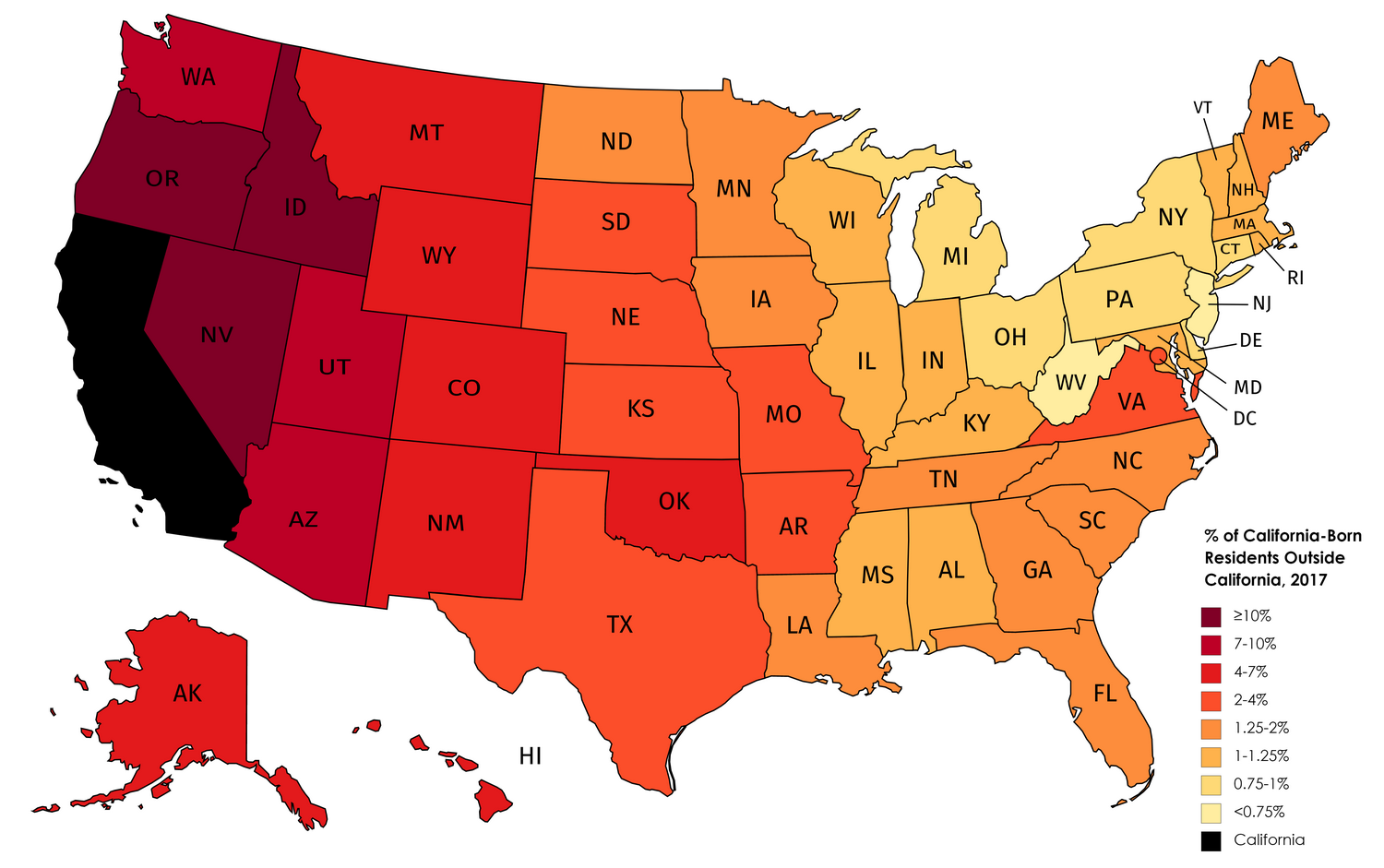California's Population: The Role Of Immigration

Table of Contents
Historical Context: Immigration Waves Shaping California's Identity
The history of immigration in California is rich and complex, directly influencing the state's identity and development. Several significant waves of immigration have profoundly impacted California's population growth and cultural landscape.
-
The Gold Rush Era (1849-1855): The discovery of gold triggered a massive influx of immigrants from across the United States and internationally, particularly from China, Latin America, and Europe. This period dramatically increased California's population, laying the foundation for its future growth. Early California immigration significantly shaped its diverse cultural fabric.
-
Post-Gold Rush Immigration: Following the Gold Rush, immigration continued, albeit at a slower pace. Chinese immigrants, despite facing discrimination, played a crucial role in building the state's infrastructure, particularly the railroads. Immigration from Mexico also remained significant, shaping the agricultural sector.
-
20th and 21st Century Immigration: The 20th and 21st centuries witnessed further significant waves of immigration, with immigrants arriving from Asia, Latin America, and other parts of the world. These immigrants contributed to California’s economic growth and cultural enrichment. Changes in immigration policies throughout these periods significantly influenced population shifts and settlement patterns within the state. Understanding the impact of these policies is key to analyzing California's population growth.
Current Immigration Trends: A Diverse Influx
Current immigration to California continues to be a defining feature of the state's demographic landscape. Recent immigration trends show a diverse influx of people from various countries.
-
Main Countries of Origin: Mexico remains a primary source of immigrants, followed by countries in Asia (India, China, Philippines) and other parts of Latin America.
-
Demographic Breakdown: Immigrants arriving in California represent a broad range of ages, genders, and education levels. While precise data fluctuates yearly, consistent reporting from organizations like the Pew Research Center offer insightful demographic breakdowns.
-
Geographical Distribution: Immigrant populations are not evenly distributed throughout California. Major urban centers like Los Angeles, San Francisco, and San Diego have significantly larger immigrant populations than more rural areas.
-
Impact of Current Immigration Policies: Current immigration policies at both the federal and state levels significantly influence the number and type of immigrants entering California. These policies have both intended and unintended consequences, requiring continuous monitoring and analysis.
Economic Contributions of Immigrants to California
Immigrants make substantial economic contributions to California. Their impact spans various sectors, strengthening the state’s economy.
-
Entrepreneurship: Immigrants are frequently involved in establishing small businesses, contributing significantly to job creation and economic dynamism. Many immigrant entrepreneurs contribute significantly to California's economy, especially in sectors like food services and retail.
-
Labor Force Participation: Immigrants constitute a significant portion of California's labor force, contributing to various industries, including agriculture, technology, and healthcare. Their labor participation is crucial to maintaining the state's economic output.
-
Tax Revenue Generation: Immigrants pay taxes, contributing to the state's revenue streams and funding vital public services. The tax revenue generated by immigrants significantly supports California's public infrastructure and services.
-
Economic Challenges: While contributing significantly, immigration also presents economic challenges, such as competition for certain jobs and the need for effective integration programs. Understanding these challenges is essential for developing policies that benefit both immigrants and native-born Californians.
Socio-Cultural Impact of Immigration on California
Immigration has profoundly impacted California's socio-cultural landscape, fostering cultural diversity and enriching the state's identity.
-
Cultural Diversity: The influx of immigrants has created a vibrant tapestry of cultures, traditions, and languages, making California one of the most diverse states in the nation. This cultural richness enhances California's unique identity.
-
Social Integration: The integration of immigrants into California society is a complex and ongoing process, with both successes and challenges. Successful integration requires community support, language acquisition programs, and equitable access to resources.
-
Impact on Social Fabric: Immigration has undeniably shaped California's social fabric, fostering both harmony and challenges related to cultural differences and social cohesion. Understanding and addressing these challenges is crucial for maintaining a cohesive and inclusive society.
The Future of Immigration and Population Growth in California
Projecting the future of immigration to California and its impact on population growth requires considering various factors, including federal and state immigration policies, economic conditions, and global events.
-
Population Projections: Demographic projections vary, but most suggest continued population growth in California, fueled in part by immigration. Understanding these projections is crucial for planning infrastructure, resources, and social services.
-
Impact of Future Immigration Policies: Future changes to immigration policies will undoubtedly influence population trends. Analyzing potential policy changes and their likely impact is vital for informed decision-making.
-
Challenges and Opportunities: Future population growth presents both challenges (e.g., housing shortages, strain on resources) and opportunities (e.g., economic growth, cultural enrichment). Proactive planning and strategic investment are crucial for maximizing opportunities while mitigating potential challenges.
Conclusion
Immigration has undeniably played, and continues to play, a crucial role in shaping California's population, economy, and cultural identity. From historical waves to current trends, the contributions of immigrants are undeniable. Understanding these trends is vital for effective policy-making and fostering a welcoming and inclusive environment.
Call to Action: Learn more about the ongoing impact of California's immigration and its effect on the state's diverse population. Further research into California's immigration policies will provide a clearer understanding of the future demographic landscape. Stay informed about the significant role of immigrant populations in California.

Featured Posts
-
 Ai Digest Transforming Repetitive Documents Into A Compelling Podcast
May 27, 2025
Ai Digest Transforming Repetitive Documents Into A Compelling Podcast
May 27, 2025 -
 Every Alien Movie Available On Hulu June 1st
May 27, 2025
Every Alien Movie Available On Hulu June 1st
May 27, 2025 -
 Congres Du Parti Socialiste Bouamrane Appelle A L Union Contre Faure
May 27, 2025
Congres Du Parti Socialiste Bouamrane Appelle A L Union Contre Faure
May 27, 2025 -
 Lagarde Nin Son Aciklamasi Avrupa Da Yueksek Belirsizlik Devam Ediyor
May 27, 2025
Lagarde Nin Son Aciklamasi Avrupa Da Yueksek Belirsizlik Devam Ediyor
May 27, 2025 -
 Almanacco 8 Marzo Cosa E Successo Oggi Compleanni E Proverbio
May 27, 2025
Almanacco 8 Marzo Cosa E Successo Oggi Compleanni E Proverbio
May 27, 2025
Latest Posts
-
 Anderlecht De Impact Van Lucratieve Biedingen Op De Club
May 30, 2025
Anderlecht De Impact Van Lucratieve Biedingen Op De Club
May 30, 2025 -
 Did Elon Musk Father Amber Heards Twins A Timeline Of Events
May 30, 2025
Did Elon Musk Father Amber Heards Twins A Timeline Of Events
May 30, 2025 -
 Afvisningens Skygge Holder Vejret Og Danmarks Skaebne
May 30, 2025
Afvisningens Skygge Holder Vejret Og Danmarks Skaebne
May 30, 2025 -
 Analyse Af Danmark Portugal Fodboldkampen
May 30, 2025
Analyse Af Danmark Portugal Fodboldkampen
May 30, 2025 -
 Goede Aanbiedingen Een Uitdaging Voor Anderlecht
May 30, 2025
Goede Aanbiedingen Een Uitdaging Voor Anderlecht
May 30, 2025
